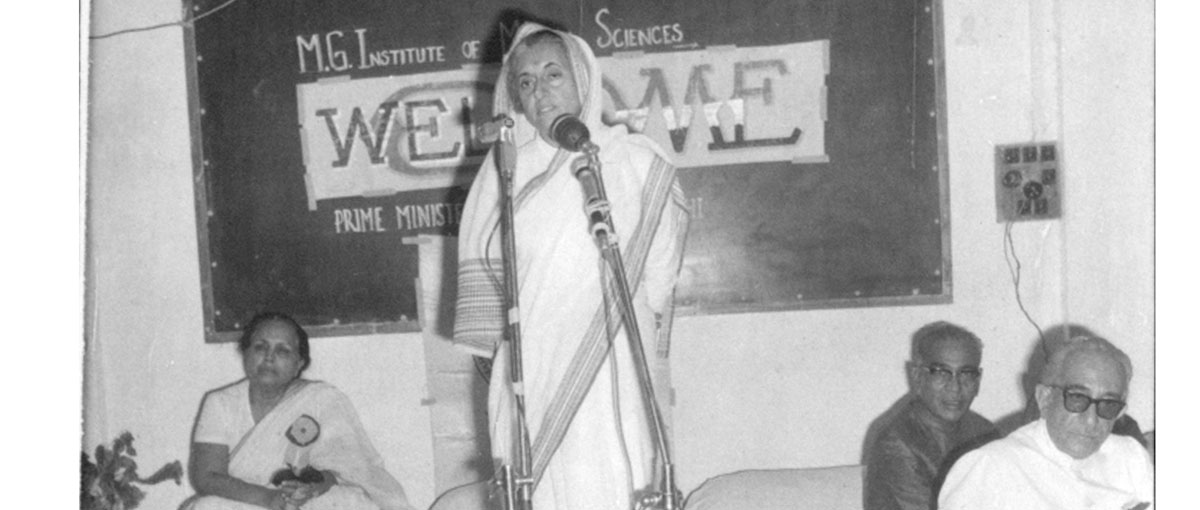History and Heritage

The name of the institute itself speaks of its historical roots. These roots go back to the time of Indian Independence Movement, and to a place originally called Shegaon, now known as Sevagram.
It was 1936, when Mahatma Gandhi left Sabarmati ashram and set up his ashram in Sevagram, a small village in Wardha town in Maharashtra. Gandhi directed the independence movement of the country from here. This has immortalized Sevagram in the history of the Nation.
In 1938, Dr Sushila Nayar, then a young medical graduate, came to Sevagram to meet her brother Pyarelal. Pyarelal was Gandhi's secretary and a link to Dr. Nayar's association with the Mahatma. Born on 26th December 1914, in Kunjah (Gujarat), now in Pakistan, Sushila was just another girl from a middle class family. It was by her sheer grit and dedication that she later on carved a national position and contributed immensely to the society.
During her stay in Sevagram, she was highly influenced by Gandhi's ideology. She also had her first encounter with community medicine in this village. When cholera broke out in Sevagram, Gandhi nudged her to tackle it. With no other medical practitioners to help her, she fought the disease almost singlehandedly. It was an experience that would continue into several such experiences which were to chisel her into a hero of public health. Dr. Nayar continued to stay for a year at Sevagram as Gandhi's personal physician. This was a time when she learnt and imbibed the lessons of austerity and abstinence from Gandhi's teachings.
After completing MD in medicine she returned to Sevagram in 1942. She zealously participated in the Quit India Movement, which was sweeping the country at that time. In the same year, she was arrested with other prominent Gandhians and sent to prison in Aga Khan Palace, Pune.
In 1944, she started a small dispensary in the premises of the ashram at Sevagram. Her next step was going to be a leap for the village. The small clinic formed outside the ashram, in a guesthouse donated by G.D Birla, was to become a seed of a hospital in Sevagram. And duly in 1945, Kasturba Hospital was born. With its 15 beds it began its service as maternity and children hospital. The hospital continued to grow under the care of the ashram from 1948 to 1954. Thereafter it was taken over by the Gandhi Smarak Nidhi (Mahatma Gandhi National Memorial Trust). On September 11, 1964 an independent registered society to manage the hospital was formed. This was Kasturba Health Society.
After Mahatma Gandhi's assassination, Dr. Nayar had joined Johns Hopkins University, USA, where she received her degree in Dr PH. Returning in 1950, she set up a tuberculosis sanitarium in Faridabad. Dr. Nayar also headed the Gandhi Memorial Leprosy Foundation. In 1952, when the first election took place in our country, she entered politics. From 1952 to 1955, she served as Health Minister of Delhi State. Subsequently, she became Speaker of the Delhi Vidhan Sabha. She was Union Health Minister again from 1962 to 1967.
During her tenure as Health Minister, she realized the difficulty of finding qualified doctors for posting in rural areas. Even though Primary Health Centres had been set up more villagers, there hardly were any doctors in these centers. It was challenging to find doctors willing to go to villages. At this point of time Lal Bahadur Shastri while addressing Central Council of Health, suggested her to start medical colleges in rural areas. This would give budding doctors an insight into the health problems in rural areas and they would be less hesitant to serve in the villages.
In line with Lal Bahadur Shastri's foresight, in 1969, and as a part of Gandhi Centenary Program, Mahatma Gandhi Institute of Medical Sciences was proposed to be set up on the soil of Sevagram. After the approval of the Planning Commission and with the blessings of the President and the Prime Minister of the country the institute was formed. It was decided that the Government of India, Maharashtra Government and the Kasturba Health society would share the expenditure on it in the proportion of 50:25:25.
When the first batch of 60 students was enrolled in the year 1969, MGIMS came up as independent India's first attempt give a new direction to rural health. Today it boasts of having groomed more than 2300 doctors. After more than three decades of its birth, MGIMS has come a long way. From a mere 15 bedded hospital to its 972 beds and a hospital with state of the art facilities, MGIMS has created its own small history. In 2014-2015, about 70,000 attended the outpatient department of the institute. More than 48,000 patients were admitted during this period.
MGIMS has grown into an institute nursing the rural community with nominal fees. It has also been working towards its community oriented mission by working strongly with its alcohol and drug de-addiction centre, which is now in its eighth year. It has also implemented the concept of health insurance in rural areas. In 2014-15 as many as 68000 families around Sevagram have availed this facility.
The name "Sevagram" which means imparting service, was given to Shegaon by Mahatma, and MGIMS came forth to live up Sevagram to its name. Looking from the microscope at that time perhaps Gandhi did see the tiny seed grow into an institution of this stature. We at MGIMS strive harder to live up to our own history and heritage.










